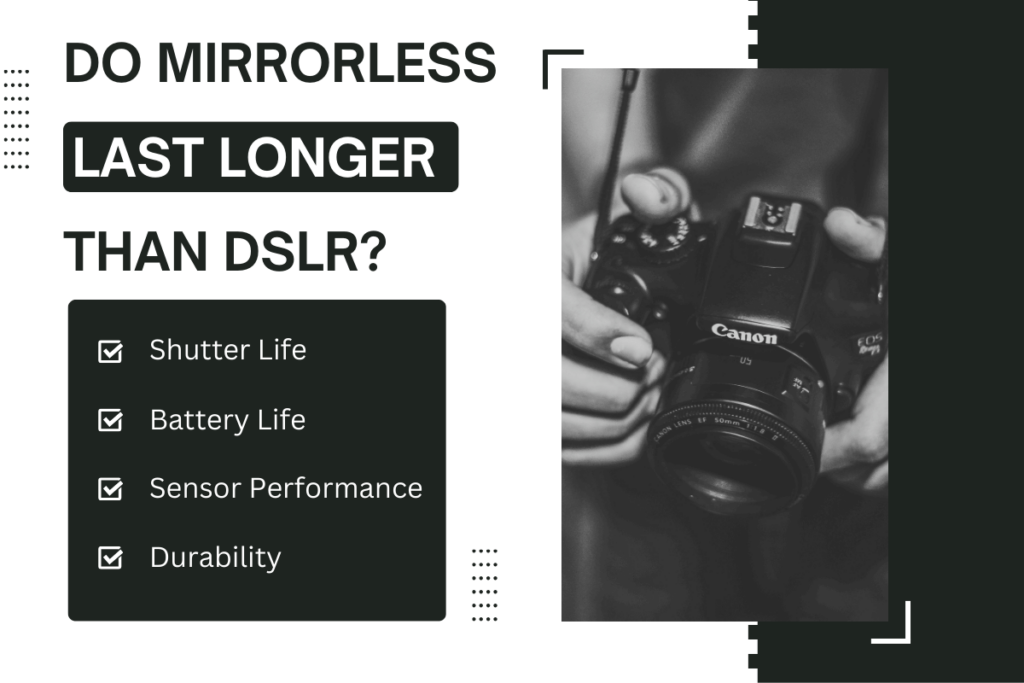
Ever wondered if your shiny new mirrorless camera will outlast the trusty old DSLR? It’s a question that’s on the mind of many photographers, from casual shooters to seasoned pros. Various factors like shutter count, battery life, sensor durability, and overall build quality can influence your camera’s longevity.
Mirrorless technology has been a game-changer in the world of photography. Does it also mean a longer lifespan for your camera? Brands and models differ, and how you use your camera plays a significant role too.
Shutter Life
Understanding Shutter Life
Shutter life is often a key indicator of a camera’s longevity. The shutter count is the number of actuations, or clicks, a camera can perform before needing maintenance or replacement.
Mirrorless vs DSLR Shutter Life
Mirrorless cameras, in many cases, boast a higher shutter life expectancy than DSLRs. This is mainly because mirrorless cameras can use an electronic shutter. This differs from the standard mechanical shutter in DSLRs. The less reliance on mechanical parts, the less wear and tear.
Let’s break down some stats:
| Camera Type | Shutter Life Expectancy |
|---|---|
| Mirrorless | 200,000 to 400,000 |
| DSLR | 100,000 to 300,000 |
You’ve probably wondered, “Do mirrorless cameras last longer than DSLR?” Well, these numbers are a clue. For instance, a Canon EOS DSLR might have a shutter life expectancy around 150,000 actuations. In contrast, a Sony Alpha series mirrorless might promise closer to 300,000. It’s all about the mechanics—or in this case, the lack thereof.
Advantages and Disadvantages in Shutter Life
Let’s weigh the pros and cons:
- Mirrorless Advantages:
- Higher shutter life expectancy
- Less mechanical wear using an electronic shutter
- DSLR Advantages:
- Physical feedback and feeling of the shutter mechanism
- Mechanical shutters provide a level of reliability and predictability
Considering the electronic advantage, you might lean towards mirrorless. But remember, DSLRs have been the workhorses of photography for decades. They’re not going without a fight. Their predictability comforts many professionals.
- Opt for the electronic shutter option when you can. It’s like choosing to walk instead of run—a little easier on the system.
- Avoid overusing continuous shooting mode. Capturing the perfect burst during your kid’s soccer game is tempting. But, it’s the camera equivalent.
Battery Life
Thinking about how often you’ll need to charge your camera may not be as exciting as pondering lens choices or image sensors. However, battery life is a key factor to consider. After all, you don’t want your camera to power down in the middle of a perfect shot.
The Importance of Battery Life
Let’s face it, the longer your camera’s battery can last, the more photos you can snap. Plus, a longer battery life means you’re less likely to miss out on capturing those spontaneous, once-in-a-lifetime moments.
Mirrorless vs DSLR: The Battery Battle
Mirrorless cameras might be more compact and have modern features. But, how do they stack up in terms of battery power? Generally, DSLRs tend to have a longer battery life. They’ve been in the game longer and have more space for larger batteries. Take the Canon EOS 5D Mark IV, a DSLR that boasts around 900 shots per charge. In comparison, the Sony A7R IV is a mirrorless counterpart. It offers around 670 shots per charge.
| Camera Model | Type | Shots Per Charge |
|---|---|---|
| Canon EOS 5D Mark IV | DSLR | 900 |
| Sony A7R IV | Mirrorless | 670 |
Making the Most of Your Battery
No matter which camera you choose, you can extend battery life with a few smart habits:
- Use power-saving modes to curb energy use
- Turn off Wi-Fi or flash when they’re not essential
- Consider carrying a spare battery to swap in when needed
By implementing these practices, you’ll ensure your camera is always ready for action.
Seeing the benefits of mirrorless technology doesn’t mean you’re doomed to a life of constant charging. With a little know-how and some extra batteries in your bag, you’re all set for a day of photography fun. Just remember, treating your camera well can make all the difference, whether it’s mirrorless or a DSLR. So, have you got some tricks up your sleeve to keep your camera lively for just a bit longer?
Sensor Performance
In the grand debate of whether mirrorless cameras last longer than DSLRs, Sensor Performance plays a pivotal role. This component is the heart of your camera’s image quality. It translates light into digital information to create the photos you love.
Understanding Sensor Performance
Think of the sensor as the canvas where your image is painted with light. A high-performing sensor means richer colors, more detail, and better images in low light. Sensor performance impacts not just image quality but also the perceived camera longevity. It influences your satisfaction over time.
Battle of the Brands: Mirrorless vs DSLR Sensors
When you’re weighing mirrorless against DSLRs, it’s like comparing apples to oranges. More accurately, you’re comparing the sensors within. Leading brands have honed their techniques to optimize sensor performance for both formats.
Mirrorless cameras, such as those from Sony and Fujifilm, use sophisticated sensors. They often match or surpass DSLR sensors. Their design allows for a shorter distance between the lens and sensor. This can result in sharper images.
On the flip side, DSLRs like the stalwarts from Canon and Nikon, have established their reputation with time-tested sensor reliability and quality. They use optical viewfinders that consume less power. This indirectly lowers battery strain and can affect sensor performance.
Pros and Cons in Sensor Smackdown
Mirrorless camera champions tend to talk about the advances in sensor technology. These advances give the cameras an edge in video and live-view photography. However, they’re not without their drawbacks—power consumption being a notable one.
DSLRs boast a robustness in sensor longevity, particularly under heavy use. But they sometimes lag behind in adopting the latest sensor innovations.
Keeping Your Sensor in Tip-Top Shape
You’ve got to protect your investment, right? Here’s how to maintain stellar sensor performance:
- Match your camera with the right lens. A poor-quality lens can negate even the most advanced sensor’s capabilities.
- Shield your gear from dust and moisture. These sneaky intruders can degrade image quality over time.
- Clean your sensor with care. This is not the time for DIY bravado. If you’re unsure, seek professional help or follow manufacturer guidelines.
Durability
When it comes to cameras, durability isn’t just about surviving drops or weather. It’s also about how well the camera preserves its functionality over time. Let’s break down what this means for you, whether you’re eyeing a mirrorless model or a classic DSLR.
The Longevity of Mirrorless Cameras
Mirrorless cameras, the new kids on the block, are being designed with fewer moving parts. No mirrors flipping up and down means there’s less to break, right? Brands like Sony and Fuji have greatly emphasized the durability of their mirrorless cameras. But do mirrorless cameras last longer than DSLRs really?
It’s hard to pin down exact lifespans because no one’s been using the same mirrorless for a decade or two. There’s optimism in the air. Users report impressive durability in the Sony Alpha series. Cameras cater to both casual photographers. They also cater to pros who put their gear through the wringer.
DSLRs: Tried and True
DSLRs aren’t to be underestimated, though. They’ve had time to refine their construction. Brands like Canon and Nikon are leading the charge. For years, photographers have turned to models like the Canon 5D or the Nikon D850. These cameras can cope with demanding environments.
Here are two big reasons why DSLRs have stood the test of time:
- Mechanical Resilience: Their physical shutter mechanisms are battle-tested.
- Body Construction: Pro-grade models boast weather sealing and magnesium alloy frames.
Tips for Boosting Your Camera’s Durability
You’re in the driver’s seat when it comes to extending the life of your camera. Here’s how:
- Use a Protective Case: It’s simple insurance against the unexpected.
- Avoid Extremes: High and low temperatures can damage your camera’s electronics.
- Regular Servicing: Like cars, cameras need check-ups to ensure they’re operating at their best.
Whatever your choice, knowing these durability factors helps ensure your next camera is a lasting investment. After all, you want to be shooting long after the novelty wears off, whether it’s with a mirrorless model or a trusty DSLR. Keep these points in mind, and you’ll be capturing memories for years to come, regardless of trends and tech shifts.
Conclusion
So there you have it – the longevity of your camera really boils down to how it’s made and how you take care of it. Mirrorless models might have an edge due to their design but don’t count DSLRs out just yet. They’re battle-tested and still going strong. Whatever your choice, remember that a little TLC goes a long way. Keep your gear clean, protected, and serviced. You’ll capture life’s moments for years to come.
Frequently Asked Questions
Do mirrorless cameras have a longer lifespan than DSLRs?
Mirrorless cameras may potentially have a longer lifespan due to having fewer moving parts than DSLRs. This can contribute to their durability. However, exact lifespans vary and depend on additional factors.
What factors affect a camera’s lifespan?
Key factors affecting camera lifespan include shutter count, battery life, sensor durability, and overall build quality. Regular maintenance and proper care also play significant roles.
Are mirrorless camera sensors more durable than those in DSLRs?
Mirrorless camera sensors may have comparable durability to those in DSLRs. Both types are built to withstand frequent use, but the technology and build can differ between models and brands.
Which brands are known for durable mirrorless cameras?
Sony and Fuji are among the brands that have received positive feedback for the durability of their mirrorless cameras. They are often praised for innovative designs that enhance longevity.
How can I increase the durability of my camera?
To boost your camera’s durability, use a protective case, avoid exposing the camera to extreme temperatures, and ensure it receives regular servicing and maintenance. Keep the camera clean and handle it with care.

